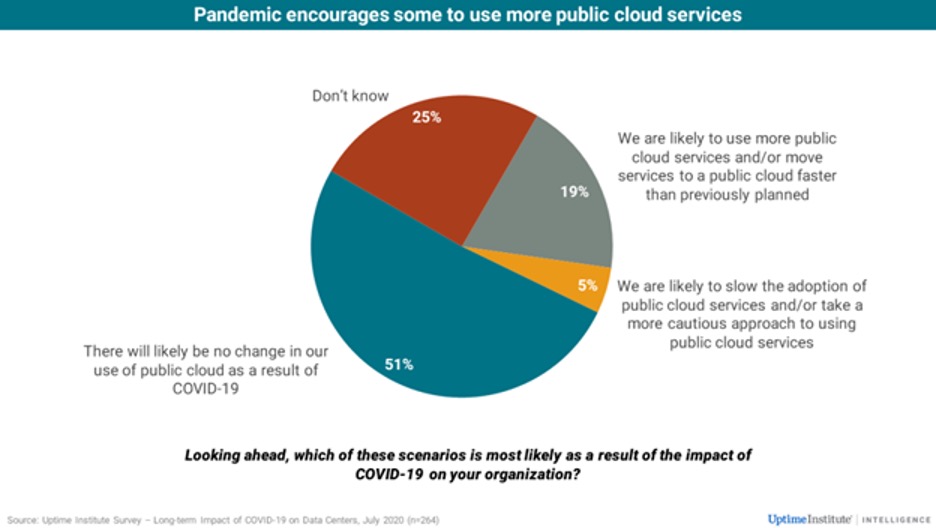
The present Covid-19 pandemic has radically altered the way of doing business in the world. Brick and mortar establishments have imposed social distancing in their shops to stop the spread of the virus. As a result, fewer people are going out and more of them are doing their business online.
Cloud computing can produce modern business advantages, allowing multiple users to view data in real-time and to share projects effortlessly. Cloud software and SaaS applications (software as a service platform) make working as a synchronized team easier and more accessible than ever.
To put it simply, cloud computing is computing based on the internet, and shifting to the cloud is the best way to ensure the business stays both current and competitive.
Previously, people would run applications or programs from software downloaded on a physical computer or server in their facility. Now, with cloud computing, there’s no need to download. Instead, they have access to all the same services online from anywhere and can see updates in real-time. By 2020, Forbes Magazine estimated up to 83% of companies will use cloud-based software to make their work easier and faster.
Here are the top reasons for switching to the cloud:
- Cloud computing is flexible
Cloud-based services are compatible with businesses with fluctuating bandwidth demands. If the company’s needs increase, it’s easy to scale up cloud capacity, drawing on the company’s remote servers. Likewise, if the need is to scale down again, the flexibility is integrated into the service.
This level of agility can give businesses using cloud computing an edge over competitors – it’s not surprising that businesses identify operational agility as a key reason for cloud adoption.
- Disaster recovery keeps data safe
Businesses of all sizes should be focusing on robust disaster recovery, but for smaller businesses without the required cash and expertise, this is often more a pipe dream than a reality. Cloud-based recovery solutions today are now accessible in various formats that save time, avoid large up-front investment, and roll up third-party expertise.
- Never miss an update
The best thing about cloud computing is that the servers are off-premise, out of sight, and can be accessed remotely. Providers will roll out regular software updates – including security updates – in case the company forgets to update their programs.
- Cloud services minimize capital expenditure
Cloud computing saves on the high cost of hardware. There is no need to buy the latest equipment to run the business applications, simply use the cloud for computing needs.
- The cloud promotes collaboration
Top teams can access, edit, and share documents anytime, from anywhere. They’ll be able to do more together and do it better. Cloud-based workflow and file sharing apps help them make updates in real-time and give them full transparency of their collaborations.
- Workstations in the cloud
Cloud computing can be accessed from anywhere with an internet connection. Since most established cloud services also offer mobile apps, it can be used on any gadget on hand.
This can result in businesses offering more flexible working perks to employees, so they can enjoy the work-life balance – without productivity declining. Working from home is an attractive offer for many employees, and thanks to cloud services is an increasingly accessible option.
- Streamlined content
The more employees and partners collaborate to work on documents, the greater the need for security control. Before the cloud, workers had to send files back and forth manually as email attachments to be scanned by one user at a time. This process had a tendency to pile up work when left unattended, creating a mess of conflicting file content, formats, and titles.
Once the transfer to cloud computing is completed, all files are stored centrally. Greater visibility means improved collaboration, which ultimately means better work and a healthier bottom line.
- Cloud computing offers security
Lost laptops are a very expensive business problem, but the loss of vital data often pales in comparison to just lost hardware. Cloud computing offers greater security when this happens. Since sensitive data is stored in the cloud, it can be accessed only through the company. A survey from Salesforce has shown that 83% of IT leaders say they trust cloud security more than ever.
- Competitive edge through SaaS
Moving to the cloud gives access to enterprise-class technology for all businesses. It also allows smaller businesses to act faster than big competitors. Pay-as-you-go service and cloud business applications mean that small outfits can compete with big businesses, and disrupt the market while remaining agile and flexible to changes.
- Cloud services save time
One of the big reasons to move to the cloud today is how well-dedicated software can ease the process of moving the company’s data to the cloud. By signing up with a specialized platform, businesses receive support during the transfer and can reach out to service teams at any time.
The problems encountered when initially transitioning to the cloud
First, during the pandemic, many companies do not have the necessary network infrastructure, or necessarily the programs, to support all their work from home staff and all their customer services on their networks.
As a result, they have to adapt quickly or rely more heavily on their use of cloud and other third-party services. The business use of cloud platform providers (Amazon Web Services, Microsoft Azure, Google Cloud Platform) and software apps as a service (Salesforce, Zoom, Teams) has increased the demand tenfold in the span of a few months.
Second, many companies foresee that the loss of an entire site due to staffing issues is a possible scenario in the future. They began planning for this with different strategies, including more remote working, greater resiliency, and greater automation.
The use of CIO and CTO
The chief information officer (CIO) and chief technology officer (CTO) will be in the front lines in their top-team support for the cloud capability needed in digital strategy, the digitization of the company, its channels of distribution, and its supply chains—all of which already needed to be moving more quickly than they were.
The company’s CEO can broker communication across the multiple parties involved, which include the CIO, CTO, CFO, chief human resources officer (CHRO), chief information security officer (CISO), and business-unit leads. Transitioning to the cloud computing represents a collective-action problem that needs a coordinated effort across the team at the top of an organization. It’s a matter of coordination, in other words, and CEOs are at top of the chain of command.
As the COVID-19 pandemic rages across the world, experts have suggested that the business case for enterprises to move to the public cloud has been significantly enhanced. Some have argued that the pandemic will hasten the decline of the business data center.
The case for an accelerated move to the public cloud may lead to one conclusion: Data centers were expensive and difficult enough to operate, even before the pandemic. Now, the costs, risks, and complexity have made the situation more complicated. With the possibility of new pandemics down the line, it will be easier, if not immediately cost-effective, to move to the cloud.
Many enterprise operators are moving in that direction. In a July 2020 Uptime Institute survey of 260 operators, a fifth (19%) said they are more prone to move to a public cloud or use public cloud services more as a result of the pandemic. Just one in twenty (5%) thought the pandemic would slow their move to a public cloud.

Benefits of transferring to the cloud
During the past two decades, IT organizations utilized a range of innovations—for example, virtualization and Linux. These innovations have made running business applications much cheaper to operate, while requiring little additional investment.
Cloud adoption has a completely different profile. Exploiting the cloud requires investment in building capabilities and migration applications. It’s more efficient in the long term, sometimes markedly so, for companies that have not fully optimized their technology environment.
The benefits coming from using the cloud include faster time-to-market, simplified innovation, easier scalability, and reduced risk. Cloud platforms can deploy new digital customer experiences in a shorter time and can support analytics that would be astronomically expensive with traditional technology platforms.
Sometimes, however, technology-funding mechanisms can limit cloud adoption. They prioritize features preferred by the business now, rather than the future infrastructure investments that will allow companies to add more efficient operations quickly and easily in the long run.
CEOs can ensure that the senior team recognizes that infrastructure investments in cloud platforms represent a competitive advantage, rather than a cost to be managed. Once the top team acknowledges the advantages, it will all fall into place, along with the technology-funding process, to move toward products or platforms, rather than projects.
Projects are one-time-only investments, funded in a yearly boom-and-bust cycle. Products, in general, require stable, ongoing funding and reliable “ownership” to optimize new functionality and ease technical debt.
The top-team operations will benefit, too, from a prioritized multiyear map of domains in which the cloud will optimize performance and digital transformation. This will prioritize investments and avoid defaulting to applications that are technically easier to migrate.
By knowing which business domains, such as order capture, billing, or supply-chain optimization would benefit most from the agility that cloud platforms can provide, teams can identify the highest-priority areas for movement to the cloud.
Consequently, funding issues will arise. Growth, for example, may be the most likely to benefit from the cloud, but it may be the least to have high margins to fund for a cloud investment. A more stable business may have higher margins, but where, exactly, should they get the money needed for the cloud?
Would it be possible to divert excess cash from other business departments this year and next, or to reduce marketing expenditures to fund the move to the cloud? Does a legacy business have the legs to support a long-lived cloud investment? Questions like these are unlikely to be asked, much less answered, without serious consultation from the CEO and other members of the top team.
A financial-information provider, for example, decides that moving applications in its customer-focused business domains, to the public cloud, will have much faster and less expensive entry into potential markets. Hosting applications in the cloud could mean that IT operations in a new country could be set up in a couple of weeks at minimum cost, instead of millions of dollars of up-front investment for each country.
Once the investment is established, the CEO can demand higher business performance in return for the cloud investment. There should be no more shifting blame for subpar outcomes to a subpar technology environment. If the commitment to the strategy for the cloud is real, it should translate into better performance. The CEO will expect that performance does improve.
The need to adapt to digital business
The COVID-19 pandemic has increased the need for companies to adopt digital business models. This can only be done by using cloud platforms which can provide the required agility, scalability, and innovation. Although there have been pitfalls and false starts in business transitions to the cloud, companies can speed up their progress by focusing investments where they will provide the most business value and by planning cloud-ready operating models.
In order to do that, they have to get there first. That’s where the CEOs come in. By first becoming more technologically savvy than they have been before, and by addressing the collaborative problems that often keep companies from adapting to new strategic roles for IT, CEOs can enhance company performance. If companies want to be ahead of the competition in a digital next normal, the CEOs must ensure that their management teams know the specific ways that cloud computing can raise revenue growth and margins and how, in close alignment, those teams can work together to create value.

A new working model
Once the funding is set, companies must bring the new partnership between IT and the businesses to create a working model that supports their growing investment in the cloud.
The model has to be an integrated system, rather than a set of separate technologies. It implies organizational revision across all of IT, and many of the business units and functions, as well. This model combines cloud-based digital technologies and agile operational capabilities into an integrated, well-coordinated approach that can boost digital strategy and transformation. The model helps end-to-end operations across the board while making technology work for them, and making the most of it across all lines of business.
Accounting for the risks
Everything that is new to a business has risks. To mitigate the risks and compliance concerns relating to the adoption of the cloud, companies must be willing to take those risks. That means holding sessions about the best remedies to reduce risks in the technology environment.
Getting the organization on board to the transition to the cloud will require special attention from the CEO. It’s easy not to pursue a cloud program when the risks are high. Instead of thinking of the risks, CEOs should insist on a logical approach by following the business strategy, while placing the risks of cloud computing in the same vein as the existing risks of the present computing and finding options, to reduce the risks of moving to the cloud.
Companies that have the right working mode will have dramatic improvements. These include good target-state economics and lower transition costs. They will also see better agility and ability to innovate.
Recruiting talent
As the company’s cloud investment improves, supported by a new, cloud-ready operating model, the CIO will next be looking for employees with the skills needed for the cloud. While cloud computing can dramatically boost the productivity of technology, it still needs specialized and sometimes hard-to-find qualified technicians. Typical talents required include full-stack developers, data engineers, cloud-security engineers, identity- and access-management specialists, and cloud engineers. These people can be hired externally or upskilled from within. CEOs must ensure current HR policies don’t hinder the process of hiring them. The basis of performance management and promotion, for example, should be expertise, rather than the number of direct reports someone oversees.
CIOs and CTOs can be the saviors of the COVID-19 response by guiding their organizations to enable pervasive remote working. The cloud gives them the means to have an even more critical role in making business strategies successful.
Conclusion:
In spite of all this, it may be safe to say that the pandemic will trigger a rapid decline in enterprise data centers and an increase in the migration of existing workloads. One of the reasons for cloud adoption, and certainly for the use of software as a service, is to enable relatively easy use of new services, such as teleconferencing. Few organizations have, in recent years, integrated hosting such services in their own data centers.
The role of the pandemic as a catalyst for change can accelerate the strong disposition among business and organizational leaders to take advantage of the cloud. Migration can be a long hard road requiring re-platforming or rewriting applications, changing security and compliance processes, and foregoing corporate control for limited transparency.
Compared to traditional IT managers, successful CIOs and CTOs in this new normal will be more involved in a company’s digital transformation as they become more technologically savvy. In a post-COVID-19 world, these executives can’t depend on vendors to figure everything out for them. They should be open-minded to new ideas and willing to learn, to take risks, and to fail fast and then quickly recover when necessary.\
Reference links:
https://journal.uptimeinstitute.com/will-the-pandemic-accelerate-the-move-to-public-cloud/
https://www.salesforce.com/uk/blog/2015/11/why-move-to-the-cloud-10-benefits-of-cloud-computing.html




